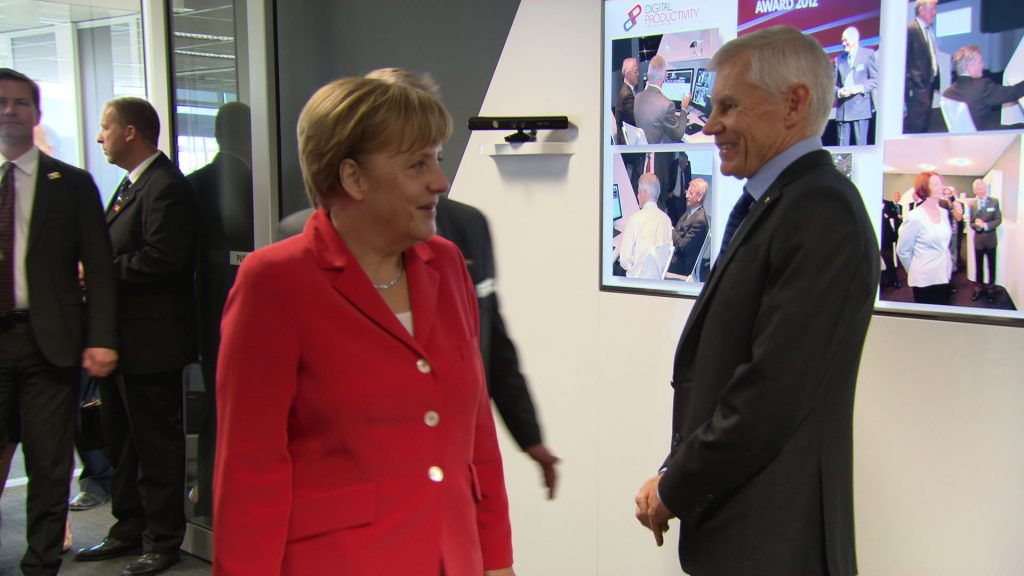Angela Merkel’s visit to NICTA this week was more than a publicity coup for the organisation. The Chancellor’s weighty presence has allowed the organisation to state its case for survival. The German Chancellor further reinforced NICTA’s pitch by speaking so highly of its research collaborations.
It may not amount to much, but Dr. Merkel’s fulsome praise does highlight a disconnect within the Coalition’s industry policy in relation to information technology R&D that’s baffling to those employed in the sector, whether in research or in commercial development.
Perhaps it’s a work in process, but frankly, right now it makes no sense and is disheartening, because IT is the horizontal industry that underpins productivity and efficiencies across all the verticals of the economy.

Information technology is weirdly off the agenda as an independent, valued sector.
Here is an example: The Tony Abbott-chaired Industry Innovation and Competitiveness Taskforce announced its agenda last month. A central plank of this cross portfolio plan was the establishment of ‘Industry Growth Centres’ in five areas where the government believes Australia has a competitive advantage.
These Industry Growth Centres will cost $188 million over four years, and their purpose is to drive better commercial outcomes by improving the linkages between researchers and businesses.
Information technology is not one of the five areas of competitive advantage identified by government. The five focus points of the policy are food and agribusiness; mining equipment, technology and services; oil, gas and energy resources; medical technologies and pharmaceuticals; and advanced manufacturing.
At the same time as these Industry Growth Centres are being established, the government is defunding the nation’s ICT research and commercial development flagship, NICTA.
It does not make sense. Although a big chunk of NICTA’s core business is research, its reason for existence is all about the linkages between research and business, and in building constructive commercial outcomes.
In relation to the digital economy (or, to put it more accurately, the economy), NICTA already serves the functions of an Industry Growth Centre, just by a different name and in an area not considered a priority by this government.
This is a pity, because the German Chancellor seemed intensely interested in the way NICTA is structured. NICTA is a complicated organisation, with many, many stakeholders and a long list of objectives.
While it’s an unwieldy web that connects 22 university partners, has 700 employees located all over Australia, involves 300 PhD students and various commercial partners, the German Chancellor seemingly likes what’s on display.
Those who interacted with Dr. Merkel on Monday said she was most interested — and most animated — in discussing structure, and how the organisation had created and spun out its own start-up companies.
German research is not set up this way. But the Chancellor was clearly interested in the NICTA model and how it is run as an independent company, rather than as a government agency or a university.
Dr Merkel is certainly not new to industry development issues related to the digital economy. She personally chairs a pan-European ICT committee. Germany and Europe face the same challenges as everywhere in developing policy that fosters research, encourages collaboration and ultimately delivers commercially attractive outcomes — all in an extremely fast evolving digital environment.
The reality is that in the digital economy, the linkages between research and the commercial world need to be stronger and deeper because competitive advantage is more fleeting. Things simply move faster, and if there is to be a commercial outcome, it must be accellerated.
The fact that NICTA now has a focus on building start-ups internally is a good thing, although its track record remains patchy.
NICTA chief executive Hugh Durrant-Whyte admits his organisation is a strange beast in the research world, but it is a powerful model and this was acknowledged by the Chancellor.
With Communications Minister Malcolm Turnbull doing some of the articulating, the Chancellor was told that NICTA is a research institution with its own VC inside the organisation. It does fundamental research, it provides the environment inside for smart people to build their ideas and it provides the early stage commercialisation capital.
Professor Durrant-Whyte says NICTA is now spinning out companies at a rate of one per quarter. These are real technology companies, with real IP. But it has taken a long time to get to this point, and it may be too little, too late.
NICTA will lose its direct federal funding, to the tune of $45 million annually, from the end of June 2016. Next financial year is the last funding year.
Realistically, a decision about its future must be made by the end of the first quarter next year. NICTA operates as an independent company, and it is likely that it would need to decide by March whether it can survive, or, whether the final year’s budget will be earmarked for winding-up the company.
Because shutting down NICTA will be an expensive — if heart-breaking — undertaking.
Professor Durrant-Whyte does not think it will come to that. But he is not giving any hints about his plan for survival either.
Perhaps the organisation formalises the structure of its “internal VC” with private sector money and private sector management.
Whatever it is, the changes will need to be dramatic, because the funding shortfall that arrives in 2016 is a chasm. It cannot be made up by commercial development collaborations alone.
NICTA is a unique organisation. To lose its research capability would be a devastating blow, just as losing its teaching capability would be a devastating blow (more than 25 per cent of the nation’s ICT PhD students come through NICTA).
But it is also an organisation in need of a shake-up and a reboot. This near-death experience — if that’s what it turns out to be — will force dramatic change. This is a stress-test that is taking the organisation to the edge.
Maybe that’s not bad industry policy. But it’s very harsh for the people involved.
Do you know more? Contact James Riley via Email.

